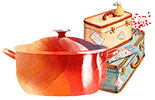A tagine is a dish and a cooking method. From traditional terracotta tagines to modern (and very expensive) enamelled cast iron tagines suitable for induction hobs, how do you choose the tagine that suits you and make your recipes a success?
Tagines of all sizes
There is everything from large family tagines, where you can serve six or seven portions, to small individual tagines used by singles or restaurants. A diameter of 22 — 24 centimetres is perfect for a family. Remember that the height of the lid is proportional to the diameter!

... and of all finishes
You can forget about aluminium tagines, which are very cheap and whose thickness does not allow you to simmer for a long time without the risk of sticking.

We also forget, at least for the kitchen, the tagines decorated with pretty colours. They are decorative pieces, they will not stand up to use and washing. I even avoid putting food on them that is too hot, as I am not sure of the "food" quality of the glaze. (This is an understatement…)
Outside Morocco, there are tagines suitable for induction hobs, cast iron, etc.

Seasoning your tagine and using it on something other than a brazier
High heat causes the tagine to crack. To avoid this, you must :
- take care to wet it well before the first use, the dish must be well moistened;
- the tagine may split, but the different pieces will not spread and will remain tightly sealed;
- use an iron plate, a dish turned upside down to keep it away from direct contact with the gas, and find the gentle heat of the brazier.
Like all earthenware dishes, a tagine cannot be washed aggressively. The layer of varnish protects it and makes it easy to wash. It is only on the outside that fat and food can burn and be difficult to clean!
From casserole to tagine to plate and back again
Nowadays, in many Moroccan families, the ingredients of the tagine are cooked in a pressure cooker and then served in the traditional dish, where each person will serve his or her own bite, with his or her "little piece of bread".
The tagine can also be placed on the table and served on plates!

Or put in a tagine anything other than a "tagine", such as .… a pizza!

Tagine is the art of stacking
When food is cooked in a tagine and not in a casserole, there is an art to layering the different ingredients in a beautiful pyramid. The meat should be at the bottom, just above the layer of onions (but you can brown it first, before setting it aside, and melting the onions).

The spices are also put in, and then the cone is assembled, with the potatoes and carrots underneath, and the courgettes, tomatoes and other quicker cooking vegetables on top, added during cooking.
There are also "flatter" tagines, such as the famous meatballs or sardines, with lots of tomatoes, or tagines made with figs, sultanas, etc., which will have very few vegetables.

Why am I telling you all this?
Because I imagine that a cooking block written in Morocco that doesn't mention tagines would seem strange to you. But to be honest, I've always let my husband make the tagines, while I'm busy with my casserole or braising pan…




